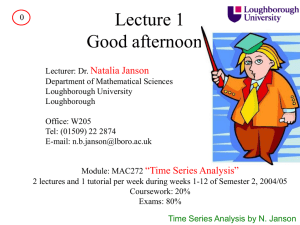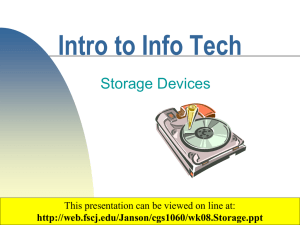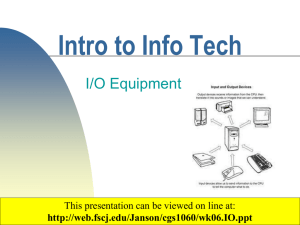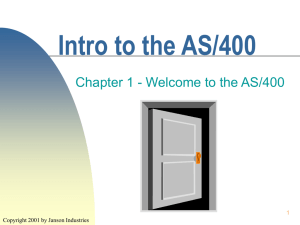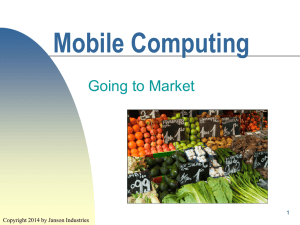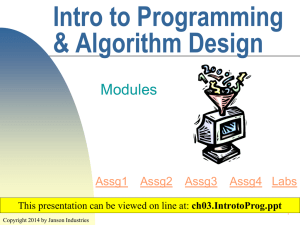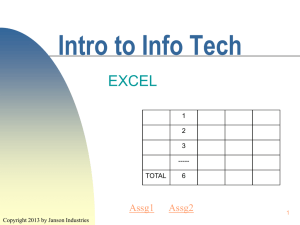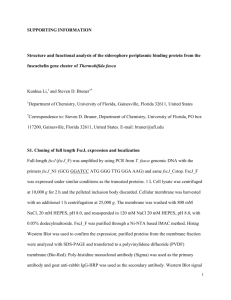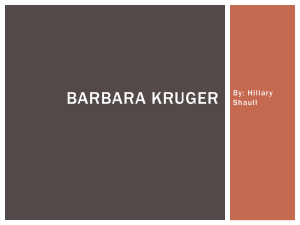Introduction to Computers
advertisement
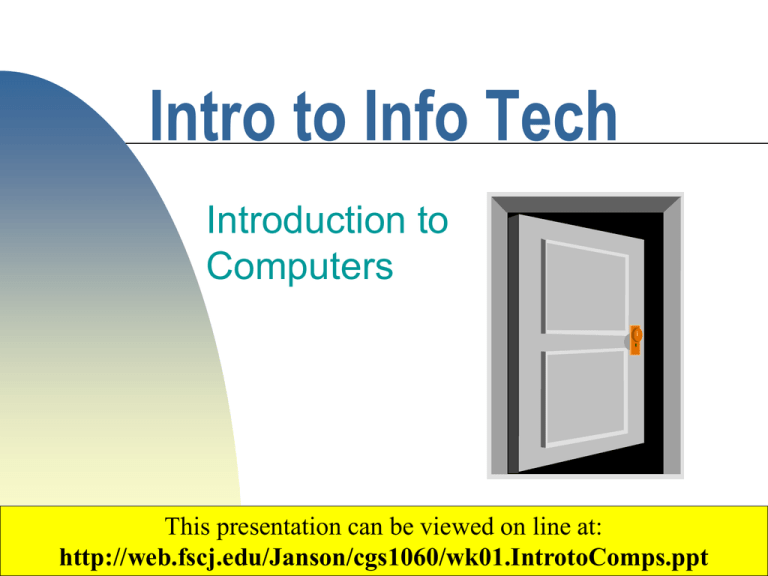
Intro to Info Tech Introduction to Computers This presentation can be viewed on line at: http://web.fscj.edu/Janson/cgs1060/wk01.IntrotoComps.ppt Copyright 2003 by Janson Industries 1 Objectives Explain Steps to success in this class Basic computer concepts Computer system ► Hardware ► Software ► Categories Applications User types 2 Copyright 2013 by Janson Industries Class Success Take good notes and read the book before you come to class Suggestion: print out PP and use as basis for notes A memory stick Put a file called IFFOUND or ICE with some contact info in it ► For when you lose it ;-) Organize your work. Pay attention to file: Naming Location Copyright 2013 by Janson Industries 3 User Ids and Passwords If you want to use the lab computers you will need to know your FSCJ user id and password User ids are usually the first 4 letters of your last name, followed by first and middle initial John Quincy Adams user id would be: adamjq If it doesn’t work, call the FSCJ Help Desk 632-3151 4 Copyright 2013 by Janson Industries Class Software If you want Access (DBMS which is needed for a class assg) for free Send your name and FSCJ email address to me by the end of the week at: ► RJANSON@FSCJ.EDU Copyright 2013 by Janson Industries An organization called DreamSpark will contact you with further info 5 Class Software As a student you can get a free copy of Office 365 This is the FSCJ blog link with the tutorial: http://blogs.fscj.edu/technews/ 2013/12/05/students-microsoftoffice-for-free/. 6 Copyright 2013 by Janson Industries Tests If you are late for a test, you will only be able to take it if no other student has left the room If you cannot make a test, you must arrange a make up before hand If an emergency arises you, must contact me and arrange for a makeup You cannot show up to the next class and expect to take a make up 7 Copyright 2013 by Janson Industries Concepts Computer Electronic device that processes data into information according to specific instructions Data: raw facts Can be text, numbers, images Information: useful/meaningful knowledge 8 Copyright 2013 by Janson Industries Data vs. Information Data processing Selection Sorting Summarizing Information Retrieval Updating 9 Copyright 2013 by Janson Industries Data vs. Information QBs plays: 1st incomplete 2nd 4 yard left side pass 3rd run 6 yards : : : : : 95th interception Raw facts: how well did the QB play? What if data processed into info: 72% Copyright 2013 by Janson Industries completion for 288 yards 3 interceptions 10 Information Game QBs data for day vs. night: 1pm/4pm/Night Passing Yds Completion % 1 1 228 78 2 N 196 82 3 4 233 67 : : : : 16 1 245 72 What if instead processed into: # Games 1pm/4pm/Night Avg Passing Yds Completion % 7 1 234 78 6 4 205 72 3 N 166 61 11 Copyright 2013 by Janson Industries Concepts Information processing cycle Input Processing Output Storage Computer can store input and output 12 Copyright 2013 by Janson Industries Concepts Input comes in two forms: Data Instructions Hardware (h/w): the computer machinery Software (s/w): group of instructions Like a recipe 13 Copyright 2013 by Janson Industries Hardware Device Categories Input device: converts human understandable input into machine understandable input Processing device: converts input into output Output device: converts machine understandable output into human understandable output Storage device: reads and writes input or output to a storage media 14 Copyright 2013 by Janson Industries Concepts Input Computer Hardware Input Input Device Keyboard Microphone Scanner Mouse Processing Output CPU Storage Device Hard drive Thumb drive CD/DVD drive Memory card slot Output Output Device Printer Monitor Speakers 15 Copyright 2013 by Janson Industries Concepts External vs. Internal Storage Internal also called Main Memory or RAM Many differences between the two Speed, capacity, persistence For now, key difference is, that MM managed by CPU External memory has a separate device that manages the media 16 Copyright 2013 by Janson Industries Concepts Run Word How Internal and External memory work with application s/w 1 Input Run Device Word CPU 3 Word RAM 2 Copy of Word Storage Device 17 Copyright 2013 by Janson Industries Concepts Communication Devices Enable computers to send and receive input and output to other computers Example: Modem Input and output sent over a "line" (transmission media) Phone line, cable, wireless A group of linked computers is called a network 18 Copyright 2013 by Janson Industries Network Network hardware consists of Transmission media Communication device(s) User nodes Television network? Phone network? Computer network? 19 Copyright 2013 by Janson Industries Internet Transmissions over the common carrier networks Phone, cable, satellite and computer networks ...that follow the rules of TCP/IP WWW is one part of the Internet that sends information as web pages 20 Copyright 2013 by Janson Industries Concepts Software (instructions) consist of many programs Types of Software System ► Enables the computer to work ► Provides basic functions for applications ► Enables the computer to work more efficiently Application ► Perform user functions 21 Copyright 2013 by Janson Industries Computer Software System software Operating Windows, Linux, OS10, IBM i, MVS Utility systems programs WINZIP, Bluetooth, anti-virus, FLAC to MP3 converter Application software Productivity Entertainment Education Copyright 2013 by Janson Industries 22 Applications Need to be installed Download Purchase on a disk Insert disk and an "install" program begins to run Copies application to the hard drive Puts list item in Program menu Creates Copyright 2013 by Janson Industries desktop icon 23 Applications Created by programmers Written in programming languages Java Visual Basic C++ 24 Copyright 2013 by Janson Industries Common Application Types Financial Online banking, tax prep, online investing Government Access to govt records, criminal DBs, facial recognition Health Care Online patient records, patient monitoring, online diagnosis, insurance claims, virtual operations25 Copyright 2013 by Janson Industries Common Application Types Science Space exploration robots, camera pill, nano-bots Publishing Books, mags, newspapers created electronically, online books Travel Online reservations, GPS, directions 26 Copyright 2013 by Janson Industries Common Application Types Manufacturing Robots used in hazardous env, CAD, CAM "Fabbers“/ 3D printers AKA desktop fabricators Essentially a robot Feed product specs, out pops product "Instead of printing a picture of a screw, you print the screw" 27 Copyright 2013 by Janson Industries Makerbot’s Cupcake CNC $750 - $1300 You build from a kit Designs available at www.thingiverse.com http://www.youtube.com/watch?v=NueRhgISweE&feature=related 28 Copyright 2013 by Janson Industries 29 Copyright 2013 by Janson Industries Digital Fabricators/3D Printers How about skipping the middle men? Who needs a design https://www.youtube.com/watch?v=PgaurYNPWu8 30 Copyright 2013 by Janson Industries Digital Fabricators Besides building a house in a day: Drastically reduce costs, injuries, waste and environmental impact Automatic embedding of communication network wiring, electrical, reinforcement, plumbing, and sensor modules Automated painting (using inkjet technology for wallpaper designs) http://www.youtube.com/watch?v=JdbJP8Gxqog http://www.contourcrafting.org/ Copyright 2013 by Janson Industries 31 Computer System Categories Personal Computer Midrange (minicomputer) Mainframe Supercomputer 32 Copyright 2013 by Janson Industries Types of Computers Size/ Capacity Speed Users PC Copyright 2013 by Janson Industries Super Midrange Mainframe Computer 33 Types of PCs Size/ Capacity Mobile Devices Speed Handheld/PDA Laptop/ (Palm Pilot, Smart Phone) Tablet Desktop 34 Copyright 2013 by Janson Industries Specialty Computer Types Game console Some can do (or be converted to do) general computer processing Embedded – very specific functions Most major appliances have these ► Cars, washing machines, etc. Servers - store and disburse a networks resources (s/w, info, music) Any general computer can be a server Though some computers built specifically to be servers 35 Copyright 2013 by Janson Industries Computer User Categories Home user has PC(s) and uses if for – Google, directions Entertainment – media player Personal finance – tax prep Communication – Email, Skype Information Small Office/Home Office: PCs networked possibly with mobile devices Microsoft Office Industry specific s/w: inventory, Quark E-commerce 36 Copyright 2013 by Janson Industries Computer User Categories Enterprise User: Mainframe networked to all types of computers Enterprise computing ► Financial, marketing, product design, inventory, sales, etc. Database Management System Microsoft Office E-commerce Email 37 Copyright 2013 by Janson Industries Computer User Categories Mobile User: FedEx deliveryman, police, ins adjuster, rental car clerk Internet access Networked to company apps Specialty s/w Power User: midrange computer, graphic artist, engineer, architect Industry specific s/w Internet access High end peripherals Copyright 2013 by Janson Industries 38 Points to Remember Copyright 2013 by Janson Industries Operating Systems enable the computer hardware to work Windows provides a GUI to perform system functions Many apps allow users to perform system functions Everything on the PC is stored in files and files are grouped into directories 39
